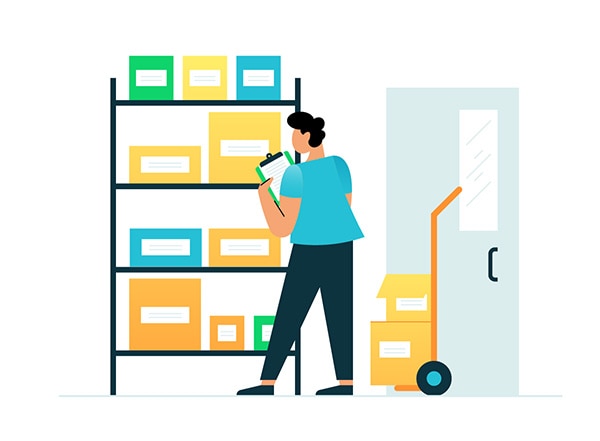Procure to pay, also referred to as P2P, is when a business integrates its purchasing department with its accounts payable department. Procurement software solutions help businesses save time and money by automating the vendor payment business process and housing the transactions in one easily accessible space.
70% OFF QuickBooks
for 3 months Ends 11/30

What is the procure to pay process and how can you use it?
What is procure to pay?
Perhaps the best way to explain the procurement process is by using an example of a business that manufactures a finished good. In this case, consider the printing company that makes business cards, brochures, signage, etc. Paper and ink are purchased frequently, and machinery that produces the marketing materials must be periodically maintained, serviced, and updated.
During the normal approval workflow process, a printer might purchase ink and paper from multiple vendors. The variables create a need for the business to carefully track purchases made by buyers or the purchasing department itself. Once there is a need for a specific good or service, the procure to pay process kicks off.
After a purchase decision, a requestor relays price and quantity information to the purchasing department or other appropriate parties. That individual then creates a purchase order (PO) that may need to be approved by one or more designated managers or owners.
The purchase order is a tracking document that businesses use to reconcile a purchase with what will ultimately be delivered and paid for by the accounts payable department or specific individuals. Traditionally, a paper document had to pass through a few pairs of hands before a supplier received payment. Spread that process across multiple vendors, and the order management process is slow and prone to human error.
For businesses looking to digitize and speed up the procure to pay cycle, software solutions streamline the payment journey from requisition to invoicing to payment. A benefit of streamlining is found in lower costs for labor and materials expenses while storing that cost data to gauge specific jobs and departments’ profitability. For these reasons, organizations that use numerous suppliers or manage several locations would do well to automate an e-procurement solution from start to finish.
The 6 steps of the procure to pay processes
Essentially, there are six basic steps to a dynamic procure to pay solution. Let’s look at each phase in more detail.
1. Purchase decision
At this point, your business needs a particular supply so that operations can continue. For a printing company, many devices can now monitor ink levels in real-time and notify a specific person when the well is running dry. Both the machine itself and a designated purchase requisition specialist recognize that a need exists.
2. Order placement
With automated solutions, smart devices can automatically request more ink via email or other electronic communication. An employee will receive a notification, but there’s little else they’ll need to do other than rely on the supply chain and wait for the receiving department to inspect the ink shipment.
3. Purchase order
After a supplier is selected, a strategic sourcing solution might create a purchase order (PO) at the same time the requisition is made and then sent to the provider along with the purchase request or shortly after that.
4. Shipment
Depending on your contract management obligations or the request’s urgency, you may receive supplies in a day or a week. And once you take receipt of the goods, you can match it up with the PO to ensure the order is correct. If using an electronic solution, the PO will likely be a mouse click or two away.
5. Invoicing
Suppose your supplier deploys an innovative solution on their end. In that case, you can expect a bill to arrive shortly after the supplies are received, invoices are matched, and shipment accuracy is verified. The terms of your agreement will determine when you need to remit payment.
6. Payment
Once the order is approved, responsibility shifts to accounts payable, which can complete invoice matching with the purchase order along with approval. Among some final steps, click-to-pay options allow you to transfer funds instantaneously to the supplier and seamlessly book the expense into your accounting system.
Now that all the steps of the procure to pay process have been laid out, here are the benefits of using P2P.
The benefits of implementing procure to pay
If your business is considering adding P2P functionality to your operations, here are three significant benefits of doing so.
1. Manage time wisely
Growing businesses can’t waste time guessing when they need to reorder materials that are crucial to their success. Reordering supplies should be triggered by P2P systems, a task that requires little time from a procurement team, who can more productively use that time saved.
2. Improve efficiencies
By electronically implementing and streamlining P2P processes, your business can benefit from ordering and payment information being under one digital roof. Researching purchases becomes much less tedious, and the odds of losing an invoice or purchase order significantly decreases. All relevant data flows effortlessly to accounting systems and can be retrieved for general or tax reporting purposes.
3. Strengthen supplier relationships
Paying vendors faster improves the supply chain management process in a few different areas. Becoming a reliable customer strengthens bonds with vendors and can lead to better payment terms and deeper discounts on goods or services. Your payment history and creditworthiness, in turn, become stronger. So, any future relationships you may form with new suppliers are aided by a sound, established financial track record.
When implementing procure to pay doesn’t make sense
A P2P solution might not be ideal for large, global companies that might be sourcing hundreds or even thousands of vendors across numerous locations in many countries. Therefore, complex organizations with many subsidiaries could have a high number of contractual agreements with suppliers that include varying terms, price points, and service-level agreements, to name a few variables.
Entities such as this typically have the resources to implement a software solution such as Enterprise Resource Planning (ERP) endeavors that are tailored to their unique needs. It may be a standalone platform that takes years to design, develop, and install. Until that point, legacy systems may be siloed and operate independently of each other even though inefficiencies persist, and reporting eventually needs to roll up to the top of the organization.
Procure to pay best practices
The easier expenses are to manage, the more time there is to be devoted to more productive pursuits. When leveraging P2P programs, it’s prudent to follow these guidelines:
- Use forecasting tools to project supplier expenses and cash flow to create budgetary expectations across all departments.
- Measure results periodically to ensure the organization is on track to stay with spend management guidelines.
- Use reporting functionality to gain deeper insights into spending that does not involve contractual obligations.
- Continuously train new and existing employees in the procurement department on the optimal use of your P2P functions.
- Leverage the process to tighten bonds with suppliers with whom loyalty will cede more favorable terms and pricing.
Final Thoughts
By relegating a significant number of routine tasks to process automation your business can increase efficiency and have more time to work on more complex tasks. One of those is your procure to pay process, which your business can streamline to cut operational costs, improve the bottom line, and free up time to focus on growing revenue.












